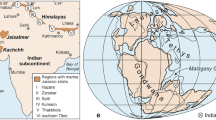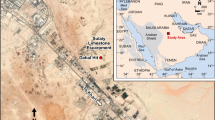Abstract
The study of the distribution law and origin of groundwater in Quaternary sediments downstream of the Red River Delta is approached in the direction of research on sequence stratigraphy and the distribution law of lithofacies according to space and time. However, the distribution law of lithofacies and groundwater depends on global sea-level changes and tectonic activities as the two most important reasons. Quaternary sediments of the Red River delta downstream have 5 sediment cycles corresponding to 5 sequences: (1) sequence 1 with Early Pleistocene age (Sq1–\({\text{Q}}_{1}^{1}\)); (2) sequence 2 with early Middle Pleistocene age (Sq2–\({\text{Q}}_{1}^{{2{\text{a}}}}\)); (3) sequence 3 with late middle Pleistocene age (Sq3–\({\text{Q}}_{1}^{{2{\text{b}}}}\)); (4) sequence 4 with early Pleistocene age (Sq4–\({\text{Q}}_{1}^{{3{\text{a}}}}\)); (5) sequence 5 with late Pleistocene–Holocene age (Sq5–\({\text{Q}}_{1}^{{3{\text{b}}}}\)–Q2). Each sequence is composed of three sedimentary systems tracts. The lowstand systems tract (LST) is characterized by a lowstand alluvial muddy sand facies complex that acts as a primary freshwater aquifer (SmarLST). The transgressive systems tract (TST) is characterized by a coastal swamp sand mud facies (MsamtTST) and a maximum transgression bay-lagoon mud facies (MmtTST) acting as an aquifuge. The highstand systems tract (HST) is characterized by sand bar facies (SamhHST) and delta plain sandy mud facies (MsamhHST). Thus, vertically Pleistocene sediments have 5 aquifers, in which each aquifer is constituted by the superposition of two successive facies complex: (1) upper part: lowstand alluvial gravelly sand facies complex (LST) and (2) lower part: highstand dune sand bar facies complex (SarLST/SamhHST). The spatial distribution of freshwater aquifers in 3 provinces Northwest Thai Binh, Ninh Binh—southeast Nam Dinh, and northwest Nam Dinh demonstrate the absence of shallow marine-bay mud facies.














Similar content being viewed by others
REFERENCES
Canh, D.V., Lai, L.T., Hung, H.V., et al., Groundwater resource of Nam Dinh Province, J. Geol., 2005, Ser. B, no. 25, pp. 31–42.
Dan, N.V., Huy, T.D., et al., Hydrogeological, hydrogeochemical characteristics and hydrogeochemical profiles in a coastal area in Vietnam. J. Mar. Sci. Techn., 2015, Ser. 15, no. 4, pp. 334–340. https://doi.org/10.15625/1859-3097/15/4/7378
Emery, D. and Myer, K.J., Sequence Stratigraphy, Oxford: Blackwell, 1996.
Krumbein, W.C., Application of logarithmic moments to size-frequency distribution of sediments. J. Sed. Petrol., 1936, vol. 6, pp. 35‒47.
Ky, H.N., Geological Map of Thai Binh – Nam Dinh, Scale 1 : 200 000, Ha Noi: Gen. Dept. Geol. Vietn., 1973.
Ky, H.N., Quaternary sediment and the formation of Bac Bo plain., Geol. J (Hanoi), 1976, vol. 126, pp. 3–8.
Lam, D.D., Holocene Sedimentary Evolution in the Red River Delta, Hanoi: Vietn. Nat. Univ. Press, 2003.
Saito, Y., Matsumoto, E., Wang, Y., Tanabe, S., and Lan Vu, Q., Climate change and human impact on the Song Hong (Red River) Delta, Vietnam, during the Holocene. Quat. Int., 2006, vol. 144, no. 1, pp. 4–28. https://doi.org/10.1016/j.quaint.2005.05.008
Lieu, N.T.H., Tanabe, S., Vub, Q.L., Hanebuthc, Till J.J., et al., Holocene Evolution of the Central Red River Delta, Northern Vietnam: Lithological and Mineralogical Investigations, Greifswald Univ., 2006, 130 p.
Mathers, S. and Zalasiewicz, J., Holocene sedimentary architecture of the Red River delta, Vietnam, J. Coast. Res., 1999, vol. 15, no. 2, pp. 314–325.
Mien, Q.N. and Phon, K.L., Some results of C14 dating in the investigation on Quaternary geology and geomorphology in Nam Dinh–Ninh Binh area, Viet Nam, J. Geol., 2000, vol. B/15, pp. 106–109.
Nghi, T, Relationship between lithofacies characteristics and groundwater of Quaternary sediment in the Red River delta, Geol. J., 1995, no. 226, pp. 11–19.
Nghi, T., Khien, H.A., Long, H.V., Lan, N.T., and Thanh, D.X., Development history of Holocene geological formations in Hung Yen-Phu Ly area to Flandri transgression phase in the Red River delta, J. Earth Sci., 2004a, vol.26, no.4, pp. 313–318.
Nghi, T., Lan, N.T., and Ha, N.T.T., Relationship between Quaternary lithofacies and groundwater characteristics of sediments in the Red River delta, J. Geol., 2004b, vol. 26, no. 5, pp.114–123.
Nghi, T., Ngo Quang Toan, Do Thi Van Thanh, Nguyen Dinh Minh, Nguyen Van Vuong, Quaternary sedimentation of the principal deltas of Vietnam, J. Southeast Asian Earth Sci., 1991, vol. 6, pp. 103–110. https://doi.org/10.1016/0743-9547(91)90101-3
Nghi, T., Nhuan, M.T., Ngoi, C. Van, Utrecht, P., et al., Holocene sedimentary evolution, geodynamic and anthropogenic control of the Balat River mouth formation (Red River delta, northern Vietnam), Z. Geol. Wiss., 2002, vol. 3, pp. 157–172.
Nghi, T., Nhuan, M., Van Ngoi, C., Van Dai, N., Xuan Thanh, D., et al., GIS and image analysis to study the process of Late Holocene sedimentary evolution in Balat River mouth, Vietnam., Geoinformatics, 2003, vol. 14, no. 1, pp. 43–48. https://doi.org/10.6010/geoinformatics.14.43
Nghi, T. and Toan, N.Q., Characteristics of sedimentary cycles and Quaternary geological evolution of Red River delta, J. Geol., 1991, no.206/207, pp. 65–69
Nghi, T., Sedimentology, Hanoi: Vietn. Nat. Univ. Press, 2012.
Nghi, T., Tuyen, N.T., Thanh, D.X., Nguyen, N.D., et al., Paleoshore and cross-boundary of late Pleistocene – Holocene systems tract in the north and middle north, The Journal of Geology, 2016, pp. 1–13.
Nghi, T., Sedimentary Geology of Vietnam, Hanoi: Vietn. Nat. Univ. Press, 2018.
Nguyen, N.T. and Trinh, H.T., Investigation of the saltwater intrusion in the Pleistocene aquifer in the coastal zone of Red River delta, Proc. 11th SEGJ Int. Symp., Japan, 2013.
Nguyen, T.H., National Report of Groundwater Period 2001-2005, Hanoi: Dept. Geol., 2005.
Nguyen, T.Hang, Trinh, H.T., Dinh, D.C., and Vu, V.M., Study on the freshwater boundary of the Pleistocene aquifer in the coastal zone of Nam Dinh province, Proc. 29th EnviroInfo and 3rd ICT4S Conf. 2015, Copenhagen, 2015.
Nguyen, V.D., Final Report of Drawing Hydrogeology Map of the Nam Dinh Province, Scale 1 : 50 000, Gen Div. Geol., Min. Industry, 1996. Catuneanu, O., Principles of Sequence Stratigraphy, Elsevier, 2007.
Phung Van Phach and Vu Van Chinh, Cenozoic tectonic activities in the Red River basin and adjacent areas, J. Mar. Sci. Techn., 2007, vol. 7/3, pp. 18–30.
Rukhin, L.B., Osnovy lithologii (Fundamentals of Lithology), Moscow: Gostoptekhizdat, 1953.
Tanabe, S., Hori, K., Saito, Y., Haruyama, S., Quoc Doanh, L., Sato, Y., and Hiraide, S., Sedimentary facies and radiocarbon dates of the Nam Dinh-1 core from the Song Hong (Red River) delta, Vietnam, J. Asian Earth Sci., 2003a., vol. 21, no. 5, pp. 503–513. https://doi.org/10.1016/S1367-9120(02)00082-2
Tanabe, S., Hori, K., Saito, Y., Haruyama, S., Vu, V.P., and Kitamura, A., Song Hong (Red River) delta evolution was related to millennium-scale Holocene sea-level changes, Quat. Sci. Rev., 2003b, vol. 22, no. 21/22. pp. 2345–2361. https://doi.org/10.1016/S0277-3791(03)00138-0
Thang, N.V., Geological and Mineral maps in Thai Binh– Nam Dinh, scale: 1/50.000. General Department of Geology and Minerals of Viet Nam, 1994.
Thanh, T.N., Current status of groundwater environment in the Red River Delta plain, Geological Journal, 2004, vol. 280, pp. 21–31.
Thanh, T.N., Some study results on groundwater environment in the Bac Bo plain, CCOP Technical Bulletin, 28, 2000, pp. 55–67.
Thanh, T.N., Groundwater supply to Nam Dinh rural area. National workshop on Hydrogeology, Viet Nam Hydrogeological Association, Hanoi, 2001, p. 161–165.
Trinh, H.T., Nguyen, N.T., Do, V.T., Vu, V.M., Nguyen, T.H., Study current status of TDS distribution in the Pleistocene aquifer in the coastal zone of Nam Dinh province, Journal of Marine Science and Technology, 2016, series 16, no. 2, pp. 151–157. https://doi.org/10.15625/1859-3097/16/2/7383
Trinh, H.T., Nguyen, N.T., Le, H.M., Vu, V.M., Application of hydrogeological modeling methods in forecasting seawater intrusion of Pleistocene aquifer in Thai Binh area, Proceedings of the 28th EnviroInfo 2014 Conference, Oldenburg, Germany, 2014.
Van Wagoner, J.C., Posamentier, H.W., Mitchum, R.M., Veil, P.R., Sarg, J.F., Loutit, T.S., and Hardenbol, J., An overview of sequence stratigraphy and key definitions. In sea-level change- An integrated AproachC.K Wilgus, B. S., HastingsC.G.St.C Kendall, H.W., Posamentier, C.A., Ross and J.C., Van Wagoner, Eds., 39-45. SEPM Special Publication 42.
Yen, H.P., Nhan, T.T., Nghi, T., Toan, N., et al., Late Pleistocene—Holocene sedimentary evolution in the coastal zone of the Red River Delta, Heliyon, 2021, vol. 7, no. 1: e05872. https://doi.org/10.1016/j.heliyon.2020.e05872
ACKNOWLEDGMENTS
In the process of researching to complete this article, the author has received the attention and support of the General Department of Geology and Minerals of Vietnam, the Northern Division of Geological Maps and the National Center for Water Resources Planning and Investigation (NAWAPI) has facilitated the authors to take samples from 30 Quaternary geological wells for additional analysis of sediment criteria and collect data of groundwater of 46 hydrogeological wells. On this occasion, the authors would like to express their deep gratitude for this valuable help.
This paper has been completed within the implementation of the grant research project KHCBTD.01/19-21 and VAST–FEB RAS Project code QTRU02.02/21-22. The research was carried out as part of the State Program for basic scientific research АААА-А19-119122090009-2.
Author information
Authors and Affiliations
Corresponding authors
Ethics declarations
The authors declare that they have no conflicts of interest.
Rights and permissions
About this article
Cite this article
Tran Nghi, Hung, D.T., Thu, T.H. et al. The Relationship between Sequence Stratigraphy and Groundwater of Quaternary Sediments in Relation to Global Sea-level Change in the Downstream Red River Delta Area. Lithol Miner Resour 57, 449–472 (2022). https://doi.org/10.1134/S002449022205008X
Received:
Revised:
Accepted:
Published:
Issue Date:
DOI: https://doi.org/10.1134/S002449022205008X




